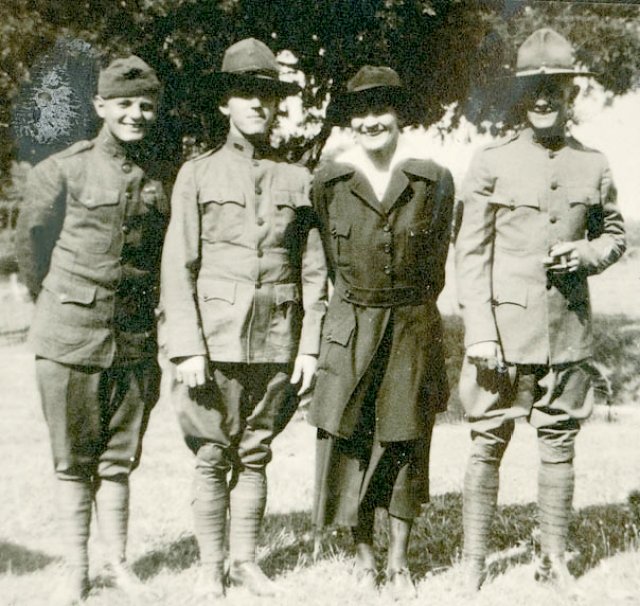The Impact of Relative Rank on Army Nurses
— by COL (Ret.) C. J. Moore, AN
From 1901 to 1920, Army nurses were appointed to active duty status without authorization of military rank or grade. In the minds of the Army leadership, these women’s positions within the military hierarchy were one rank above noncommissioned officers, but one rank below West Point Cadets!1 During World War I, to carry the responsibilities of a duty position without commensurate authority, rights, or privileges was problematic at the least and dangerous at the most. Nurses complained that they were frequently challenged, ignored, or treated with disrespect by reason of their dubious position.

Army Nurse Linnie Leckrone with her brothers – who also served in WWII, but unlike her, with military rank.
|
The Army Reorganization Act of 1920 tried to rectify these problems by granting relative rank for all Army nurses.
2 While nurses were not commissioned officers, their relative standing in the army corresponded to that of commissioned officers. The “assimilated ranks” of lieutenant, captain, and major were authorized. The superintendent (corps chief) was appointed a major, the assistant superintendent and directors pinned on captains’ bars, chief nurses were selected as first lieutenants and staff nurses were appointed as second lieutenants.
3
Although the Act authorized the female nurses to wear insignia, the War Department (later Department of Defense) choose not to prescribe rights and privileges on parity with male officers. However, for the first time, nurses were allowed to attend special courses in civilian schools on full pay. Superintendent Stimson was pleased that eighteen nurses were sent to civilian schools during the first five years after nurses were authorized relative rank.4 Nurses also were authorized increased baggage and freight allowance, excellent insurance, and membership in officer’s club.
Authorization of rank dramatically changed the work environment both for the nurses and for the Army. For example, in the office of the Superintendent in Washington, DC, Major Julia Stimson was empowered to sign all personnel, logistical and administrative actions that came across her desk instead of sending them by messenger to another office for approval. Her prominence within the Army medical department increased now that she actively participated in all official meetings and ceremonies rather than receiving the information secondhand or observing from the back of the room. An unnamed nurse reflected, “Rank has done a whole lot to increase the efficiency of the Army Nurse Corps … due to the authority that goes with it.”5
By clarifying the lines of authority with subordinates and superiors, Army nurses could exercise authority. One nurse expressed her personal feelings in this way: “It has been a source of great satisfaction to realize that nurses have the right to a defined status, and are not dependent on courtesy that might or might not be extended.”6 The fight for full rank and for equal status in the military lay in the future, but the authorization for relative rank was celebrated as one of the first victories.
__________________
1 __________“Bars for the Army Nurse,” St. Louis Post Dispatch, April 4, 1920.
2 Carolyn Feller, and Debora Cox, Highlights in the History of the Army Nurse Corps (Washington, DC: US Army Center of Military History, 2001), 10.
3 __________”Miss Lieutenant Arrives,” Courier Journal, June 19, 1920.
4 Julia Stimson, “Rank for Nurses,” American Journal of Nursing, 26(April, 1926), 272.
5 Ibid, 272.
6 Ibid, 274.